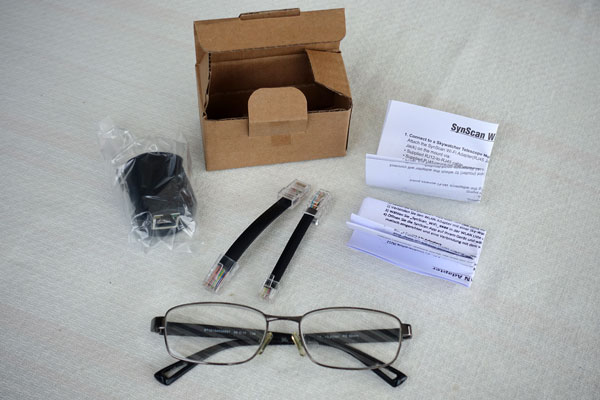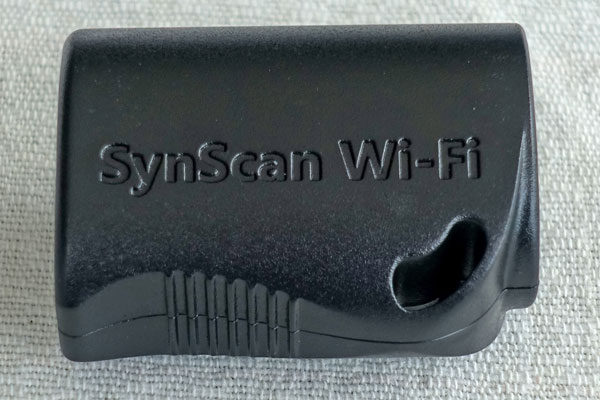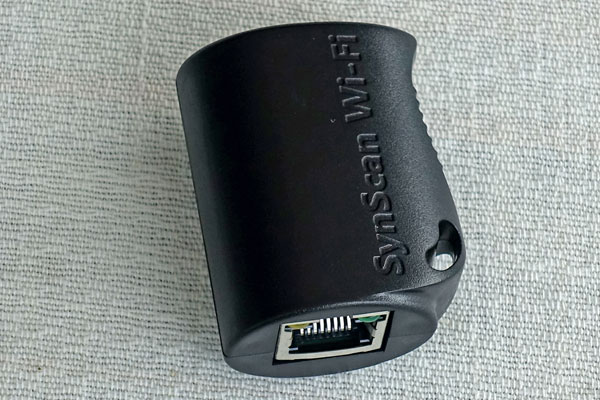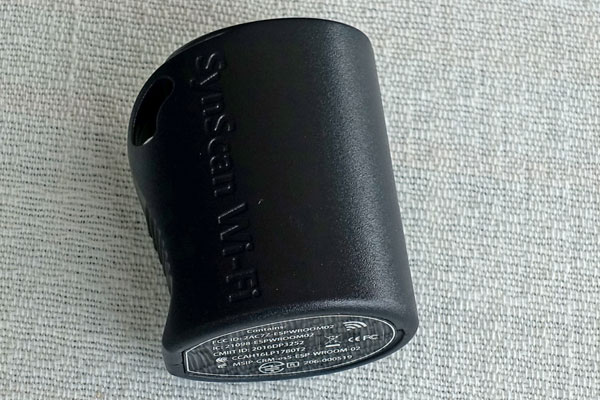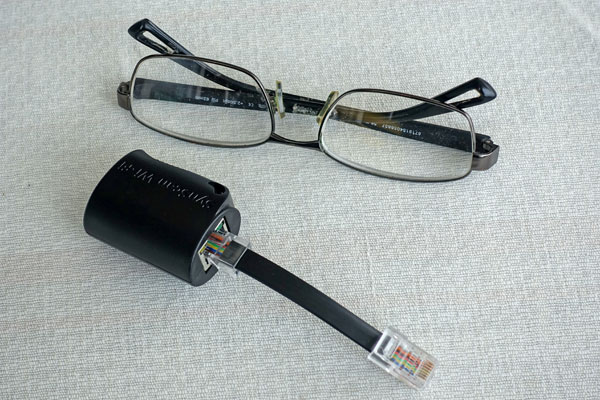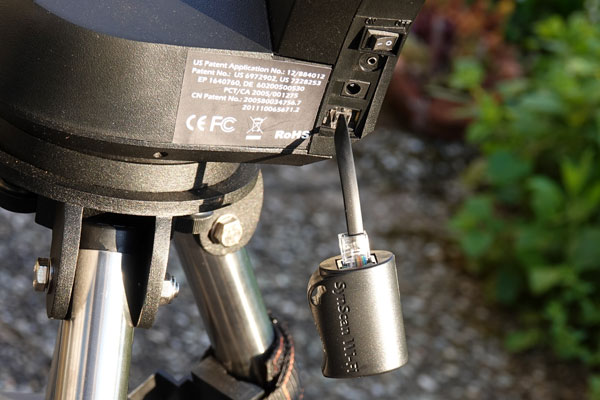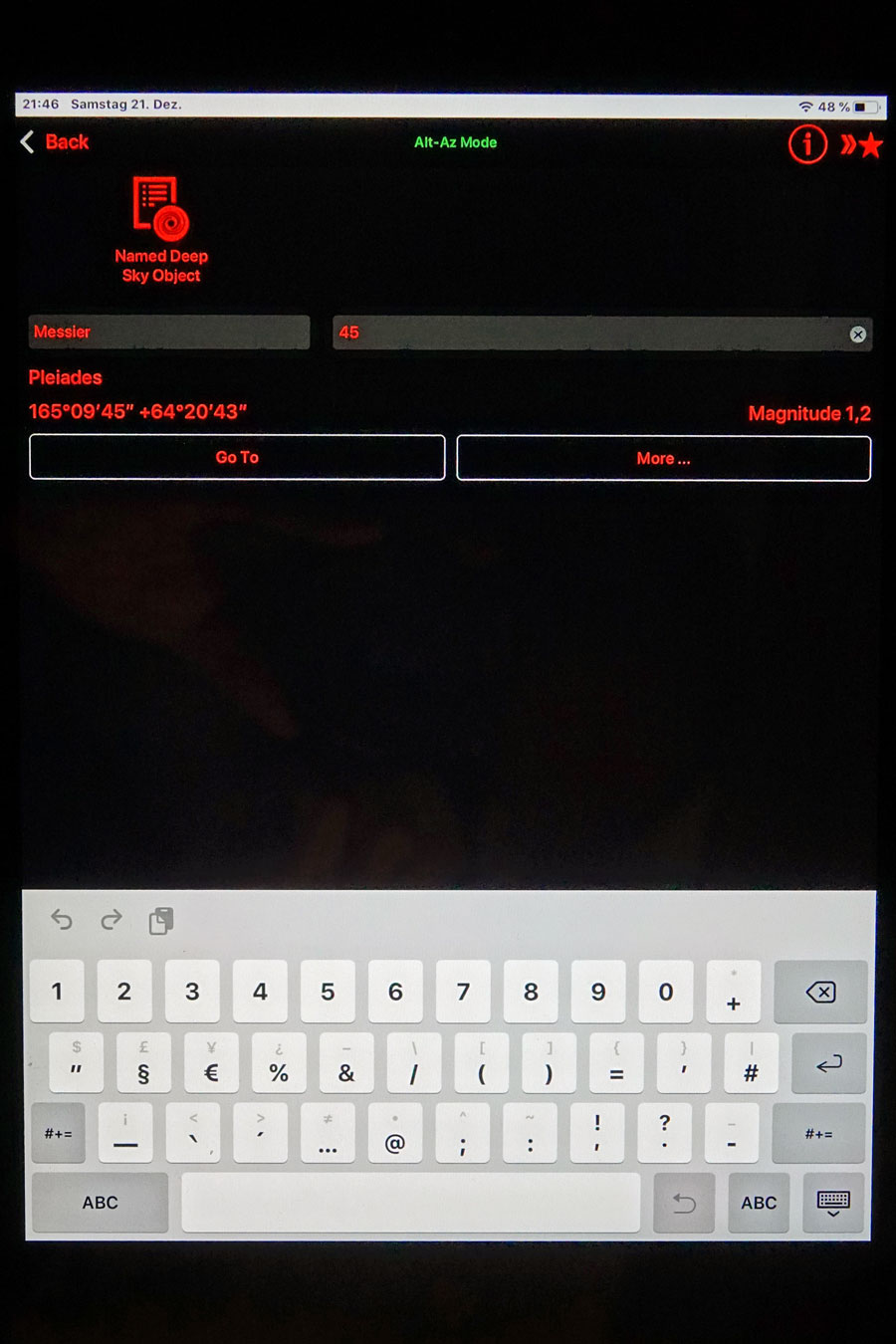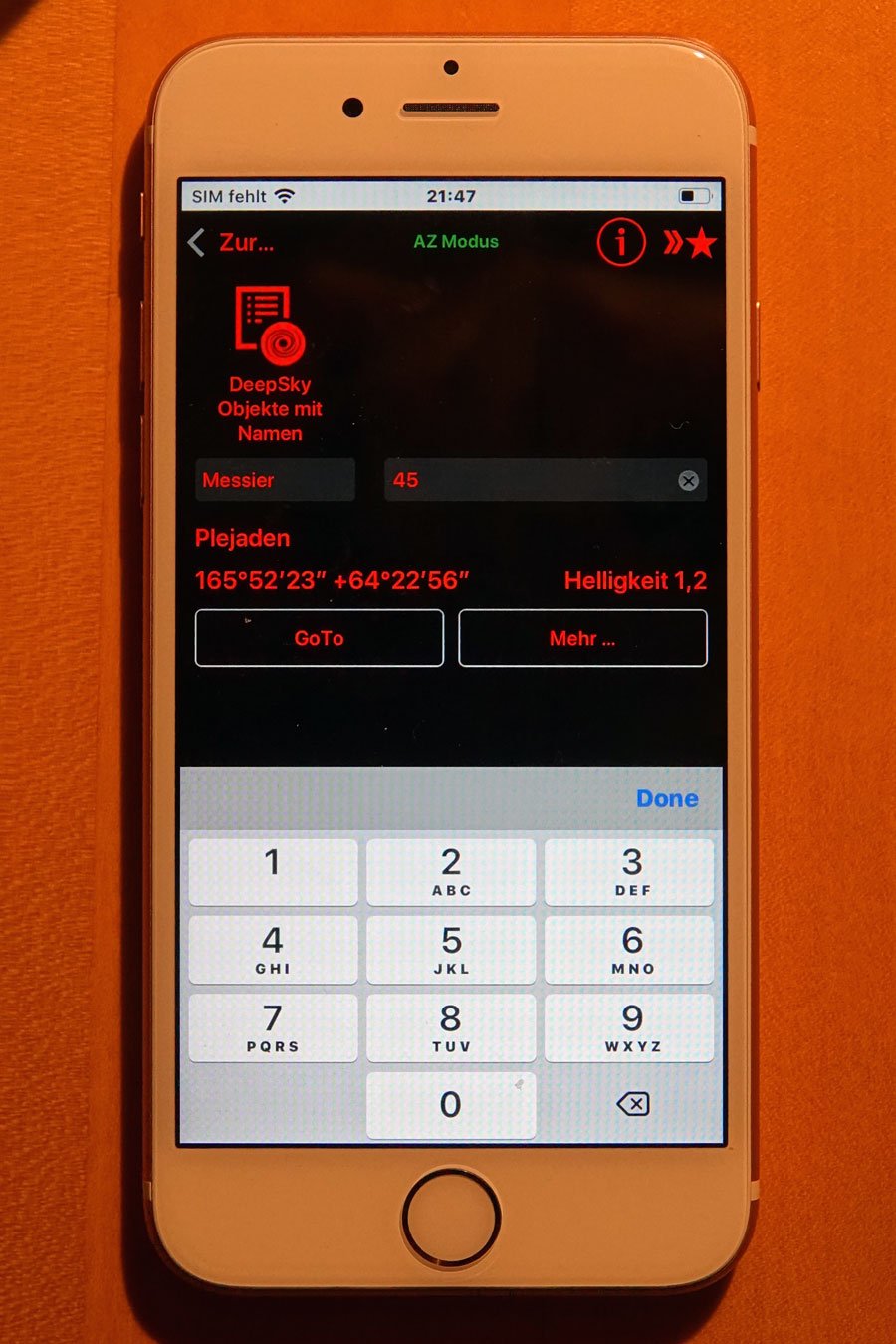Sky-Watcher SynScan WLAN - First Experiences
Introduction | Look | First Experiences | My Results in Brief | Preliminary Conclusions | Links
Archive
On this page, I present my first experiences with the SynScan WLAN adapter from Sky-Watcher. This device allows me to control my Sky-Watcher Star Discovery AZ GoTo telescope mount with the SynScan app for iPad or Windows, instead of using the hand box. It is also possible to control the telescope via Synscan app with the astronomy application SkySafari Plus or Pro in version 5 and 6. On the Apple platform, however, this is somewhat more complex than when using Android or Windows because you need two computing devices.
Note: There is another WiFi adapter available that is called SkyFi 3 (current version; or III...) and sold by Simulation Curriculum.
| Note: I sold my Sky-Watcher Star Discovery AZ GoTo telescope mount including the SynScan WLAN adapter at the end of November 2024. I therefore can no longer report any further experiences with this tube here. |
See also:
- Simulation Curriculum SkyWire Information Archive
- Sky-WatcherSynScan WLAN Information Archive
- Celestron StarSense AutoAlign for Sky-Watcher Information Archive
- Sky-Watcher SynScan WLAN - First Experiences Archive
- Sky-Watcher SynScan WLAN - Further Experiences Archive
- Celestron StarSense AutoAlign for Sky-Watcher - First Experiences Archive
- Celestron StarSense AutoAlign for Sky-Watcher - Further Experiences Archive
Introduction
I came across the SynScan WLAN adapter through an e-mail contact in April 2019. This WLAN module is compatible with all Sky-Watcher GoTo mounts and allows wireless control of the telescope via smartphone, tablet, or computer using the SynScan or SynScan Pro app. These apps support the SkySafari Plus/Pro planetarium software for Android and Apple iOS, but Apple iOS requires two devices at the same time (two iOS devices or one iOS device and one Macintosh).
The WLAN adapter is connected to the serial connection for handboxes on the mount and draws its power from it. It creates its own WLAN network to which the mobile devices or computers are connected. I can report here only about iOS/OS X and the Windows App, where the whole thing did not work as smoothly as I had imagined initially. On this page, I describe my first experiences.
Note: If you are only interested in the results of my first attempts, you can jump directly to My Results in Brief!
Look
|
Box content (and glasses...) |
The adapter module |
Ditto |
|
Ditto |
Ditto, with cable |
Ditto, connected to the mount |
First Experiences
Here I describe my first experiences with the SynScan WLAN adapter up to the time when I managed for the first and second time to control the telescope with SkySafari 5 and 6.
Note: If you do not want to read the lengthy description of my first experiences, you can skip them and continue reading at My Results in Brief!
First tests on April 25, 2019 in the Afternoon
After the arrival of the Sky-Watcher SynScan WLAN adapter, I downloaded the SynScan app from the Apple App Store (only the simple version at first) and started it, connected the WLAN adapter to the hand box socket of the mount, connected and switched on the power supply (the WLAN adapter is powered by the mount) and finally entered some settings in the SynScan app.
After some trial and error, I soon managed to establish a WLAN connection to the iPad ("Find devices" in the connection settings), this basically works by itself. However, the app crashed all the time on the iPad: when I was in the settings, in the help, and after establishing the connection to the mount also in other places... But I did not find anything about this in the forum discussions that I had read before on the Internet!
In the beginning, nothing seemed to happen when I pressed the direction keys on the app screen. But then I noticed that, at the "standard speed" 5, the mount moved slightly and that you have to prick your ears to hear the motors of the control. At higher speeds (8 - 9) you can hear the motor well, especially the one driving the vertical axis. So the motor movement of the mount worked right away, even though I did not notice this at the beginning!
After having performed a "test alignment," I was able to navigate
to sky objects (stars, DSO). Finding stars and DSOs also seemed to work, as
far as I was able to judge this in daylight. However, the app
always crashed whenever I wanted to return from a DSO to the list
of DSOs by clicking "Back"*.
That was annoying! After some trial and error, I noticed that the alignment
was still working after a crash. Apparently, the app simply continues from
where it was when it is restarted. Certain data, which apparently are not saved,
have to be re-entered each time, for example the activation of the encoders,
which was annoying as well! After these first tests I came to the conclusion
that I was basically able to control the telescope with the SynScan app
on the iPad, but only from "restart" of
the app to "restart"...
*) I had not researched the exact circumstances of the crashes at that time
- and only many days later I found a way to avoid these crashes. More about
that below!
I was not able to establish a connection to SkySafari on the Mac during these first tests (and that remained so for many further tests and days...). In the course of these first tests, however, I concluded from the behavior and error messages of SkySafari that a dot is needed also at the end of the IP in the telescope settings for the IP address. Unfortunately, this was a fatal mistake, as it turned out one day!
Tests on April 25, 2019 in the Evening
On the same day after 9 p.m., I did another test with a telescope mounted and encountered some other problems. In "night mode" instead of crashing after "Back" from a DSO, I got a cryptic error message; when I pressed "GoTo", the only remaining button, another one came up, this time in plaintext (supposedly, such a message appeared before, because a library was not included, but that problem should be fixed long ago...). The "Back" button was missing now, and I was only able to get out of this trap by restarting... Thus, almost everything remained the same...
Tests on April 26, 2019 in the Afternoon/Evening and on April 27, 2019 in the Evening (I Do not Know the Details Anymore...)
Meanwhile, I had downloaded the Windows app (there is only the Pro version for Windows) and was able to try it out now. It worked, but only if I set the IP to 192.168.4.1. In the evening, I found that the Windows app lost its icons under certain circumstances. This makes the operation a game of chance...
In the meantime, I had also downloaded the Pro version of the SynScan app for the iPad and was able to try it out as well. As expected, I found no differences between the standard and the Pro app in terms of bugs and crashes! At least, I came to the conclusion that the crashes are probably not related to the day/night mode of the user interface. After all, I was able to narrow down the crash conditions a bit. The crashes (or error messages) only occurred when I selected DSOs by number from a list (Messier, Caldwell, NGC) - and under no other condition (not even when I selected DSOs by name). It was the "Back" from the detail screen, where the crash happened.
I found out that the night mode is disturbed as soon as the keyboard appears (e.g. if you want to enter a number) that is white. This is not very professional!
When using the SynScan app under Windows, I was not able to use SkySafari 5/6 on the Mac under OS X or on the iPad. I suspect that this was my mistake, but I did not pursue this further at first...
In an astronomy forum, I found that the paper documentation contains errors (the online help is correct). For external applications, including SkySafari, use the following:
- Port: 11882 instead of 11880 (this is correct in the online help!)
- IP: the IP of the SynScan App system (mostly 192.168.4.2), but not 192.168.4.1.
So I had specified a wrong port so far! However, the correct port did not lead to success! I also tried various settings for the IP, but still had no success...
Tests on April 28, 2019 in the Evening/Night
In the evening and a little later in the night of April 28. 2019 I tested again with a telescope (PS 72/432) to see how the WLAN module for the Star Discovery mount and the SynScan app on the iPad can "practically" be used to observe sky objects. As always before, error messages occurred after calling "Back" from a DSO, which led to a crash or forced a restart. After that I restarted the app every time and started with another DSO (I often just switched between two DSOs...). In the end, I came to the conclusion that I can "live" with this, that is, use the WLAN adapter without SkySafari.
Tests at the Beginning of May 2019
At the beginning of May 2019, I once again tested the SynScan app on Windows and found out that the icons only disappear in "day mode", that is, with a white screen - no matter what mode (day, night, auto) was selected. This problem may occur after the app declares "Night". But when it does that, and if this assumption is indeed true, I have not been able to clarify yet. Once, the icons seemed to disappear due to a mouse movement, but this was not reproducible and probably just coincidence. I was not able to make any further progress, including with regard to SkySafari...
Tests on May 7, 2019 in the Afternoon - the Breakthrough
During the next few days I had lost all of my interest in continuing with trying whether I would be able to connect the WLAN module to SkySafari. An "emergency operation" with the SynScan App alone worked, and that seemed OK and sufficient to me. In addition, I did not really know what to try out anymore. And the forums also did not give me any further hints, except that others also had problems with Macs...
On May 7, 2019, I got myself up again and tried the whole thing once more
as
a "dry
run,"
that is, without a telescope and during the day. I used the SynScan app on
the iPad again, but at some point in time, I changed my behavior for "unknown
reasons" in hindsight.
Up to then, I had pressed the "Enter" key after entering the
Messier (or other DSO list...) number to confirm the entry. This time, however,
I immediately clicked the "GoTo" button
after entering the numbers. While the "detail screen" appeared after "Enter",
after clicking "GoTo", the app now remained on an "overview
screen,"
just in the same way as the Windows app behaved. On this screen, I was now
able to enter another Messier number, click "GoTo," and access the
next DSO - and this without any crashes! (I still got crashes, however, whenever
I accessed the detail screen via "Enter" after
keying in the numbers and clicked "Back" there*.)
*) In the dark, an error message would appear instead... But from when on???
Perhaps, after some internal automatic had declared "night"...
This was indeed a huge step forward! Now I had found a way to switch from DSO to DSO without experiencing a crash (or error messages and related restarts).
Update: The new App version 1.17.1 from the end of August 2019 still
exhibits the same behavior with respect to crashes after pressing "Enter -
what a pity (or shame...)!
Update (Dec 21, 2019): See below for differences between the iPad and the iPhone
version!
This result motivated me to try to connect to SkySafari once again! I started SkySafari 6 on the MacBook Pro. I was never able to clarify in the discussion forums whether this version works for other hobby astronomers or whether only SkySafari 5 works with the SynScan app. I tried some things again; among others, I omitted the dot behind the last digit of the IP number. I also played around with the network. At some point in time, I first connected the iPad to the network and then the Mac (IP = 192.168.4.2 - thus, without dot at the end) - and suddenly SkySafari was connected to the telescope - the "usual" error message did not appear! I was able to move around the mount with SkySafari, visualize the target point to which the mount points in the sky in various ways, and try out some of the things that are possible in this application. And then I tried SkySafari 5, and this worked as well! So SkySafari worked after all! Of course, how long the WLAN connection would remain stable was another question. But now I finally had reached the point where I might have encountered the problem that Mr. Kloß had warned me about, namely WLAN aborts...
As mentioned at the beginning, I had usually entered the IP in the SkySafari telescope settings with a dot at the end, because then it took longer until an error message appeared and because this error message also sounded more plausible to me. But this never worked! "Of course not," I might say afterwards! For the input of the IP in the telescope settings of SkySafari therefore applies:
- IP without dot at the end!!!
- depending on which IP the iPad SynScan app was assigned to, exactly this IP (mostly 192.168.4.2)
By the way, the progress of the GoTo process in SkySafari is also displayed by the SynScan app; afterwards, the app returns to the main screen.
I soon got a small foretaste of the "connection problems!" The connection was immediately lost whenever the SynScan app was not in the foreground on the iPad. This happened, for example, when I looked in the iPad settings to find out which IP the iPad had assigned to the SynScan app. Other reasons for interruptions might be that networks "push themselves forward" because they are stronger than the WLAN network of the adapter and then connect automatically. But I still lack the practical experience to tell more about this...
Tests on May 12, 2019 in the Afternoon - Confirmation and "Refinements"...
On May 12, 2019, I did another test in the afternoon and was again able to work with the combination SynScan App on the iPad, Skysafari 5/6 on the Macintosh. It is important to find out in advance, which IP number the respective devices were assigned to so that you can enter the IP of the SynScan app in the SkySafari telescope settings.
I still was not able to get the combination of SynScan App under Windows with Parallels Desktop on the Macintosh and SkySafari 6 on the iPad to work, and I will not pursue this any further. Nor will I follow up why the icons in the Windows version of the SynScan app sometimes disappear...
I was further able to limit the crash conditions on the iPad. Crashes only happen when you reach the detail screen with "Enter" and leave it with "Back". If you access it via the "More..." button, the app does not crash when you press "Back". Very strange, but now I know what I am NOT allowed to do!
If you start a GoTo search with SkySafari, the SynScan app also displays this on the iPad (GoTo PC Target); then the app returns to the main screen. The alignment obviously has to be done, as with SkyWire, with the SynScan app (there with the handbox) before you can use the GoTo command. The "Align" command only performs a "synchronization" of the respective sky area. More details can be found in the SkySafari help. "Align" works if the deviation between "actual" and "target" (for a celestial object) is not too large, otherwise you will get an error message. Typically, but not always, this appears with a deviation of 1 degree and more.
Update December 21, 2019
In December 2019, I was forced to buy a smartphone in order to be able to operate my upcoming eVscope telescope using an app. I decided for a used iPhone 6s and, of course, tried out immediately how the SynScan app would behave on my just acquired iPhone.
The SnyScan app worked well on the iPhone, and I was even able to control the Star Discovery mount using SkySafari 6 on my MacBook - at least, temporarily... This did, however, not work on my iPad for unknown reasons. On the next day, however, I was able to control the mount using SkySafari on the iPad. Eventually, I was even able to use my iPad and my Mac at the same time with the corresponding versions of SkySafari 6! It still remains, however, to be clarified why SkySafari sometimes connects to the SynScan module and and sometimes not...
What I really want to share here is, however, that there is an important difference between the app versions on the iPhone and the iPad that I was only able to find after I had also acquired an iPhone. On the iPad, the app always crashes, when I press "Enter" after entering the number for a DSO - I am just used to doing so. I had realized that I can avoid these crashes by not pressing "Enter" and just pressing "GoTo". As I now found out, on the iPhone, just a numeric keypad comes up - so there is no opportunity for me to press "Enter" and crash! See the photos below:
|
iPad version of the SynScan app with a large keyboard, including an "Enter" key... |
iPhone version of the SynScan app with a numeric keypad (no "Enter" key!) |
Thus, on the iPhone the app will never crash for this reason (only for other ones...)! Probably, the developers never tested their app thoroughly on an iPad...
Final Words
That concludes my report about my "first experiences!" So I have come up at a "workable configuration" by now. Further reports will focus on the "optimization" of the configuration...
It should also be noted that the crash problem of the iPad app is no longer annoying if you control the telescope with SkySafari, because you can then approach the targets using SkySafari (which is, after all, the point of all this...)!
My Results in Brief
Note: The Sky-Watcher SynScan WLAN adapter is operated with different devices and under different operating systems. I am only dealing with the case that the SynScan App (normal or Pro version) is running on the Apple iPad under IOS and SkySafari is running on the Apple Macintosh under OS X. My attempts to run the adapter with the Windows version of the SynScan app and SkySafari on the iPad failed and are therefore not discussed here!
My first attempts with the SynScan app on the iPad led to several crashes, which I was not able to reproduce later except for one. I have not found any reports about such crashes anywhere else. I still get crashes or error messages, which finally require a restart of the app, whenever I conclude the input of the DSO number (Messier, Caldwell, NGC) with "Enter" and am transferred to the "detail screen" for the selected DSO. The "GoTo" still works fine, but a "Back" to the screen, on I can enter the next DSO number, leads to a crash (in day mode) or an error message (in night mode). Under all other conditions, especially when I click the "GoTo" button after entering the number, the app works! I therefore avoid in any case to conclude the input "automatically" with "Enter", as I am used to!
Update: I found that on an iPhone you get only a numeric keypad without an "Enter" key. Thus, here you will never crash for the reason mentioned above.
So far I have only used the SynScan app in the default settings; I have only tried night mode as an "extra." However, this mode is disturbed as soon as the keyboard appears on the screen (for example, if you want to enter a number) that is white. This is not very professional!
I was able to successfully use the WLAN adapter with the SynScan App on the iPad and SkySafari 5 as well as 6 on the Apple Macintosh. Important are the correct IP number (without a dot at the end!) and the correct port number (11882, wrongly indicated on the printed manual!) in the SkySafari telescope settings. The IP number must be the number that is assigned to the SynScan app on the iPad!
When I control the telescope with SkySafari, the described crashes of the SynScan app on the iPad are no longer a problem. But the alignment has to be done with the SynScan app, which offers several methods to choose from (I typically use the 2-star alignment*). In SkySafari you can improve the alignment for certain regions of the sky with the "Align" command (in the instructions it is called a "Synchronization"). But if the deviation between "actual" and "target" is too large for a DSO (which is used for synchronizing!), an error message appears. This is the case at a deviation of about one degree, but seems to fluctuate.
*) Since an update of the SynScan app, the 2-star alignment is no longer available, and I mostly used the 1-star alignment.
So far, I have always connected the SynScan app with the WLAN of the WLAN adapter first, then the Macintosh on which SkySafari was running. To what extent this order is critical, I do not know yet.
My astronomy dealer Mr. Kloß had warned me against purchasing the WLAN adapter with regard to operating it with Apple devices, in particular he warned against sudden WLAN interruptions. So far, I can only report on the following:
- The WLAN connection gets lost off as soon as the SynScan app is no longer running in the foreground, for example, if I want to look up the IP number in the IOS settings or if I bring other apps into the foreground.
- It is possible that other WLAN networks in the environment (especially the own one!) may also push themselves forward if they are stronger than the SynScan network or if the SynScan network was interrupted. Perhaps you should switch off the automatic connection to WLAN networks as long as you work with the SynScan WLAN adapter. Due to my lack of experience, I cannot state anything about this yet.
Preliminary Conclusions
My astronomy dealer Mr. Kloß had warned me against WLAN aborts when using the WLAN adapter with Apple devices, especially against sudden WLAN aborts. But first I had completely different problems with the WLAN adapter and also with its cooperation with the planetarium software SkySafari. I described my experiences above. And with this "preliminary conclusion" they have reached the point that I could in principle start to control the Star Discovery mount and telescope with the planetarium software SkySafari, or just with the SynScan app alone, and this in an "Apple environment".
Experiences with the practical operation, that is, controlling the Star Discovery mount and telescope with the planetarium software SkySafari or just with the SynScan app alone in an "Apple environment", can be found on page Sky-Watcher Star Discovery AZ GoTo Mount - SynScan WLAN - Further Experiences.
| Note: I sold my Sky-Watcher Star Discovery AZ GoTo telescope mount including the SynScan WLAN adapter at the end of November 2024. I therefore can no longer report any further experiences with this tube here. |
Links
- SynScan WLAN: www.teleskop-spezialisten.de/shop/Mounts-Accessories/Tracking-and-GoTo/SKYWATCHER-SYNSCAN-WLAN-WiFi-Wireless-ADAPTER-Control-of-the-mounting-via-SmartPhone-or-Tablets::3634.html?language=en
- SkyFi 3: skysafariastronomy.com/skyfi-3-professional-astronomy-telescope-control.html
- SkyFi III Wireless Scope Control Package: store.simulationcurriculum.com/collections/frontpage/products/skyfi-iii-wireless-scope-control-package
| 28.11.2024 |
